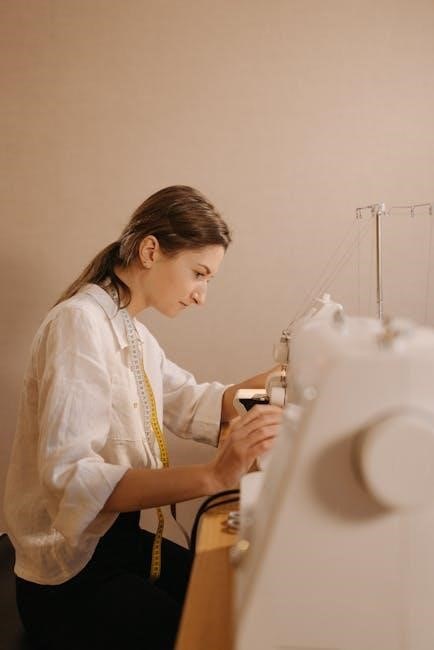
singer manual sewing machine
The Singer manual sewing machine is a timeless, durable device known for its mechanical simplicity and versatility. It remains a popular choice for sewists of all skill levels due to its reliability and ease of use. With a rich history and proven performance, it continues to be a trusted tool for both practical and creative sewing projects, embodying the essence of traditional sewing craftsmanship.
1.1 Overview of the Singer Brand
The Singer brand, founded in 1851, is a legendary name in sewing technology. Known for innovation and durability, Singer has been a trusted name for over 170 years, offering high-quality sewing machines. From early mechanical models to modern designs, Singer has consistently delivered reliable tools for sewists worldwide. The brand’s commitment to excellence and user-friendly designs has made its manual sewing machines particularly popular among hobbyists and professionals alike; Singer’s legacy continues to inspire creativity and craftsmanship in sewing communities globally.
1.2 Importance of Manual Sewing Machines
Manual sewing machines, like the Singer model, hold significant value for their durability and versatility. They are preferred for their mechanical simplicity, offering reliability and control over stitches. Unlike modern automatic machines, manuals are often built to last, with fewer electronic components prone to failure. Many sewists appreciate the tactile experience and precision these machines provide. Additionally, manual machines are eco-friendly, requiring no electricity and promoting sustainable sewing practices. Their timeless design and ease of maintenance make them a cherished tool for both beginners and experienced crafters, ensuring their relevance in the digital age.
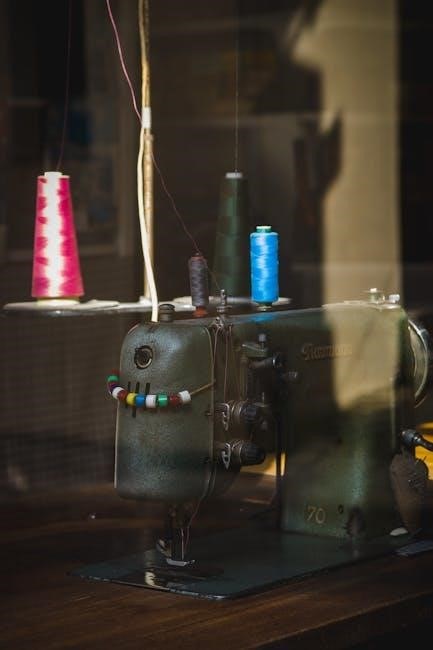
History and Evolution of Singer Sewing Machines
Singer Sewing Machines, founded by Isaac Singer in 1851, revolutionized sewing with the first practical sewing machine. Over the years, Singer introduced innovative designs, improving stitch quality and user experience, becoming a global leader in sewing technology.
2.1 The Founding of the Singer Company
The Singer Company was founded in 1851 by Isaac Singer, an American inventor and entrepreneur, who revolutionized sewing with his practical sewing machine design. Singer’s machine simplified the sewing process, making it more accessible for both home use and industrial purposes. The company quickly gained prominence, becoming a global leader in sewing technology. Singer’s innovation addressed the growing demand for efficient sewing solutions, paving the way for the development of manual and automatic sewing machines that remain iconic in the industry today.
2.2 Key Milestones in Singer Sewing Machine Development
The Singer Company marked significant milestones, starting with Isaac Singer’s 1851 patent for the practical sewing machine. The introduction of the “Turtle Back” model in 1856 and the “Red Eye” model in 1858 showcased innovative designs. By the early 1900s, Singer became a global leader, producing over 1 million machines annually. The 1960s saw the launch of the Heavy Duty 4432 and 4411 models, renowned for their durability and versatility. These machines exemplified Singer’s commitment to innovation and quality, catering to both home and industrial use, and remain celebrated for their robust construction and reliability.
Design and Mechanics of the Singer Manual Sewing Machine
The Singer manual sewing machine features a robust metal frame, mechanical components, and a handwheel for precise control. Its durable design ensures smooth operation and versatility in sewing various fabrics.
3.1 Overview of the Machine’s Construction
The Singer manual sewing machine is built with a sturdy metal frame, ensuring durability and stability during operation. Its compact design features a mechanical system driven by a handwheel, offering precise control over stitching. The machine’s exterior is typically made of high-quality materials, such as cast metal, which contributes to its longevity. Internal components, including gears and levers, are engineered for smooth functionality. This construction allows the machine to handle various fabrics with ease, making it a reliable choice for both casual and dedicated sewists. Its timeless design emphasizes functionality and simplicity, ensuring consistent performance.
3.2 Understanding the Mechanical Components
The Singer manual sewing machine operates through a series of interlinked mechanical components. The handwheel drives the machine’s gears, which rotate the needle bar and bobbin mechanism. A tension disc regulates thread tightness, while the take-up lever ensures even stitch formation. The bobbin case and feed dogs work together to create consistent stitching. Metal construction enhances durability, with components designed for smooth, precise operation. This mechanical setup allows for manual control over stitching speed and pattern, making it ideal for precise sewing tasks. Understanding these parts is key to optimizing the machine’s performance and longevity.
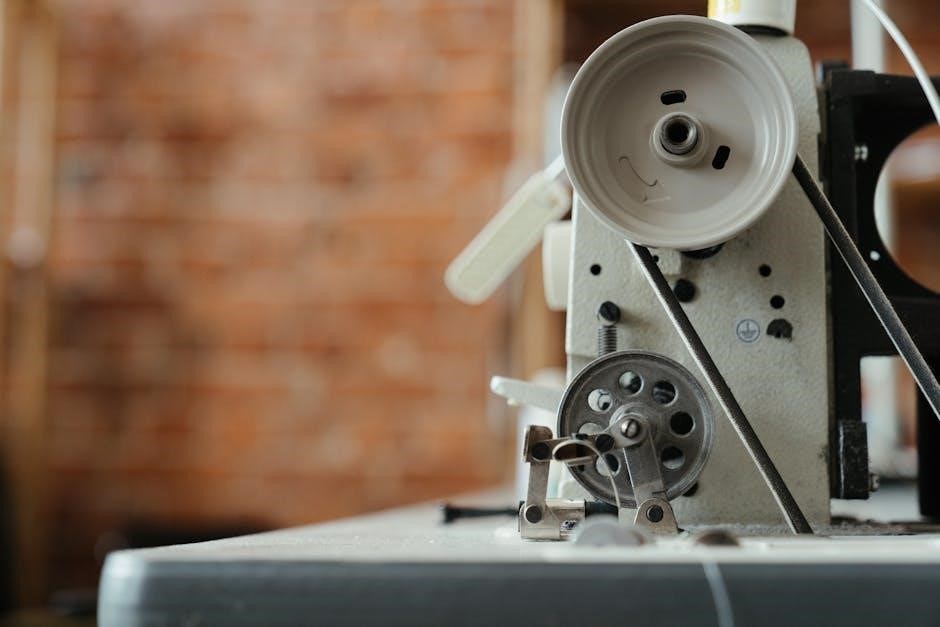
Maintenance and Care for the Singer Manual Sewing Machine
Regular cleaning, oiling, and checking for wear are essential to maintain the machine’s performance. Proper care ensures smooth operation, prevents jamming, and extends its lifespan.
4.1 Cleaning the Machine
Cleaning the Singer manual sewing machine is essential for maintaining its performance. Start by removing dust and fluff from visible areas, paying attention to the feed dogs and bobbin compartment. Use a soft brush or cotton swab to gently sweep away debris. Avoid harsh chemicals, as they may damage the finish. Regularly wipe down the machine with a dry cloth to prevent dust buildup. For intricate parts, a small, dry paintbrush can be effective. Proper cleaning ensures smooth operation and prevents thread jams, keeping your machine in optimal condition for years of reliable use.
4.2 Oiling and Lubrication Techniques
Regular oiling is crucial for maintaining the Singer manual sewing machine’s smooth operation. Use high-quality sewing machine oil, applying a few drops to the bobbin area and moving parts. Turn the handwheel gently to distribute the oil evenly. Avoid over-lubrication, as excess oil can attract dust and create residue. Always refer to the manual for specific oiling points. Proper lubrication ensures reduced friction, prevents wear, and keeps the machine running effortlessly. Consistent oiling enhances durability and performance, making it essential for long-term maintenance.
4.3 Regular Maintenance Schedule
A well-structured maintenance schedule is vital for the Singer manual sewing machine’s longevity. Clean the machine weekly, paying attention to dust and lint accumulation, especially around the feed dogs and bobbin area. Oil the mechanical components every 10 hours of use to ensure smooth operation. Every month, inspect the tension discs and take-up lever for proper alignment. Annually, consider having the machine serviced by a professional to check for wear and replace any worn parts. Consistent maintenance prevents mechanical issues, ensuring optimal performance and extending the machine’s lifespan.

User Experience with the Singer Manual Sewing Machine
The Singer manual sewing machine offers a satisfying, hands-on sewing experience. Its mechanical simplicity makes it intuitive for beginners, while experienced sewists appreciate its reliability and creative control.
5.1 Ease of Use for Beginners
The Singer manual sewing machine is remarkably user-friendly, making it an excellent choice for beginners. Its mechanical simplicity ensures smooth operation, with an intuitive design that allows new users to grasp basic functions quickly. The machine’s durable construction and straightforward controls minimize confusion, while its consistent stitching delivers professional-quality results. Additionally, the Singer manual sewing machine comes with clear instructional materials, guiding beginners through setup and operation. Online communities and workshops further support newcomers, offering tips and troubleshooting advice, ensuring a seamless learning experience. This accessibility makes it a favorite among those new to sewing.
5.2 Common Issues and Troubleshooting
Despite its reliability, the Singer manual sewing machine can encounter issues such as uneven stitching or thread tension problems. Jamming often occurs due to improper threading or debris buildup. Regular cleaning and oiling can prevent mechanical faults. If the machine skips stitches, check the needle for damage or alignment issues. Thread tension adjustments may resolve loose or tight stitching. Consulting the manual or online forums provides practical solutions. Proper maintenance and troubleshooting ensure smooth operation, making it easier for users to address and resolve common challenges effectively.

Accessories and Attachments for the Singer Manual Sewing Machine
Essential accessories like zipper feet, hemming guides, and quilting attachments enhance sewing capabilities. These tools expand the machine’s versatility, allowing for specialized stitching and fabric handling. Online resources offer durable, compatible parts, ensuring optimal performance for various sewing projects.
6.1 Essential Accessories for Enhanced Sewing
Essential accessories like zipper feet, buttonhole attachments, and edge guides enhance sewing precision. These tools allow for specialized stitching and better fabric control, making tasks like inserting zippers or sewing straight lines easier. Additional attachments, such as quilting bars or embroidery hoops, expand creative possibilities. Using genuine or compatible Singer parts ensures optimal performance. Accessories are widely available online, with resources offering durable, high-quality options to maintain and enhance your machine’s functionality. Investing in the right attachments can elevate your sewing experience and unlock new creative potentials for both beginners and seasoned sewists alike.
6.2 How to Use Different Attachments Effectively
Using attachments effectively begins with understanding their purpose. Zipper feet simplify installing zippers, while buttonhole attachments create perfect buttonholes. Edge guides help maintain straight seams. Always consult the manual for installation steps. Ensure the attachment is compatible with your Singer model and securely fastened. Test on scrap fabric before sewing actual projects. Adjustments may be needed for optimal results. Proper use enhances stitch quality and expands creative possibilities, making sewing tasks more efficient and enjoyable. Regularly clean and store attachments to maintain their functionality over time.

Comparing Manual vs. Automatic Singer Sewing Machines
Manual Singer sewing machines are durable, cost-effective, and ideal for basic tasks, while automatic models offer advanced features for heavy-duty projects, catering to different sewing needs effectively.
7.1 Pros and Cons of Manual Sewing Machines
Manual sewing machines, like the Singer, offer durability and cost-effectiveness, making them ideal for basic sewing tasks. They are easy to maintain and operate without electricity, perfect for beginners. However, they lack advanced features and automation, requiring manual control for stitch variation. While they excel in simplicity and reliability, newer models may have plastic parts that compromise longevity. Older models, with metal components, are often more robust but heavier. Despite these trade-offs, manual machines remain a practical choice for those prioritizing affordability and straightforward sewing needs.
7.2 Key Differences Between Manual and Automatic Models
Manual Singer sewing machines rely on mechanical operation, often without electricity, offering simplicity and portability. They typically feature fewer stitch options but excel at basic tasks. Automatic models, however, are computerized, providing advanced features like automatic threading, multiple stitch patterns, and faster operation. Automatic machines are heavier and more expensive but offer greater versatility for complex projects. Manual models are ideal for those preferring simplicity and reliability, while automatic models cater to users needing advanced functionality and efficiency in their sewing endeavors.

Tips for Getting the Most Out of Your Singer Manual Sewing Machine
- Regularly oil and clean the machine to ensure smooth operation.
- Use the correct needle size and thread type for your fabric.
- Adjust thread tension properly to avoid stitching issues.
- Practice on scrap fabric before sewing actual projects.
8.1 Optimizing Stitch Quality
To achieve optimal stitch quality with your Singer manual sewing machine, ensure proper needle alignment and thread tension. Regularly clean and oil the machine to maintain smooth operation. Use high-quality threads and needles suitable for your fabric type. Adjust the tension dials according to the thickness of the material to prevent loose or tight stitches. Guide the fabric steadily without pulling, as this can distort the seam. Practice on scrap fabric to refine your technique. Consistent maintenance and attention to detail will enhance your sewing results and extend the machine’s lifespan.
8.2 Managing Thread Tension Effectively
Proper thread tension is crucial for consistent stitching on the Singer manual sewing machine. Begin by threading the machine correctly, ensuring the thread passes through all guides smoothly. Adjust the tension dials to achieve a balanced stitch, where the top and bottom threads are evenly visible. Test the tension on scrap fabric before sewing your project. If the fabric puckers, the tension may be too tight; if the stitches are loose, it may be too slack. Avoid over-tightening, as this can damage the machine or fabric. Regularly check and adjust tension for different fabrics or thread types to ensure optimal sewing performance; Proper management prevents issues like uneven stitches or thread breakage, ensuring professional-quality results. Always refer to the manual for specific guidance on tension adjustment for your Singer model. By maintaining the right tension, you can enhance both the quality and longevity of your sewing projects.
Troubleshooting Common Problems
Address thread issues, jams, and mechanical hiccups by checking tension, clearing debris, and consulting the manual for guidance. Regular maintenance often prevents these common issues.
9.1 Resolving Thread Tension Issues
Improper thread tension is a common problem in Singer manual sewing machines, leading to uneven stitches or fabric bunching. To resolve this, ensure the thread is properly seated in the tension discs and that the bobbin is correctly wound. Adjust the tension knob gently, testing stitches on scrap fabric. If issues persist, clean lint from the tension assembly and consult the manual for specific guidance. Regularly checking and maintaining thread tension ensures smooth sewing and prevents machine damage over time. Proper adjustment is key to achieving consistent stitch quality.
9.2 Fixing Jamming and Skipping Stitches
Jamming and skipping stitches in a Singer manual sewing machine often result from improper thread tension, lint buildup, or incorrect needle alignment. To fix this, first, clean the machine thoroughly, paying attention to the bobbin area and feed dogs. Ensure the needle is properly installed and compatible with the fabric. Check for tangled thread or debris in the tension discs. Gently rethread the machine, following the manual’s guidance; If stitches still skip, adjust the stitch length and width or consult a professional for further assistance to restore smooth operation.
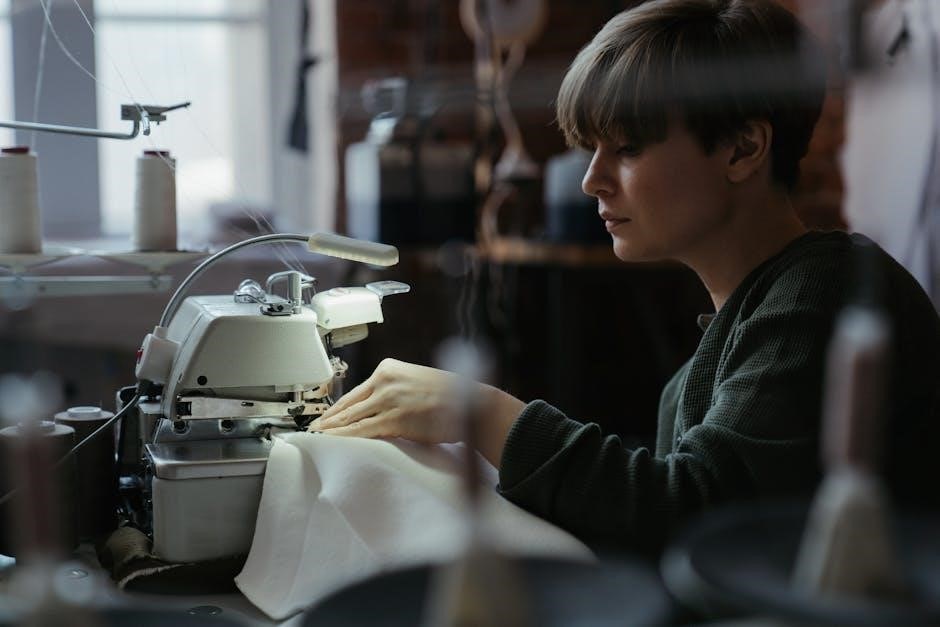
The Singer Manual Sewing Machine Community
The Singer manual sewing machine community is vibrant, with enthusiasts sharing knowledge, tips, and resources online. Forums and groups foster collaboration, helping users troubleshoot and enhance their sewing experiences.
10.1 Online Forums and Groups
Singer manual sewing machine enthusiasts actively engage in online forums and groups, sharing tips, troubleshooting, and admiration for these machines. Dedicated spaces like Reddit’s r/Sewing and Facebook groups focused on vintage sewing machines provide vibrant communities. Members often discuss maintenance, repair, and creative projects. These platforms also serve as valuable resources for identifying and valuing vintage Singer models, with users sharing their expertise and experiences. The sense of camaraderie and shared passion fosters a supportive environment, making these forums indispensable for both novices and seasoned users of Singer manual sewing machines.
10.2 Workshops and Classes for Manual Sewing Machine Users
Workshops and classes dedicated to Singer manual sewing machines offer hands-on learning experiences, ideal for mastering the use of these vintage devices. These sessions often cover maintenance, troubleshooting, and advanced sewing techniques. Instructors provide personalized guidance, helping participants optimize their machine’s performance. Many classes focus on creative projects, enabling users to explore the machine’s full potential. Whether for beginners or experienced sewists, these workshops foster skill development and confidence. They also serve as excellent opportunities to connect with fellow enthusiasts, creating a sense of community and shared knowledge.

Environmental Impact and Sustainability
The Singer manual sewing machine promotes sustainability by minimizing electronic waste and reducing energy consumption. Its durability and repairable design encourage longevity, lowering environmental impact compared to modern appliances.
11.1 Eco-Friendly Aspects of Manual Sewing Machines
Manual sewing machines like the Singer model are inherently eco-friendly, requiring no electricity and producing minimal waste. Their durable construction reduces the need for frequent replacements, while repairable components extend their lifespan. Unlike modern automated machines, manual designs often feature metal parts, avoiding plastic waste. Additionally, they encourage sustainable sewing practices by promoting repair, maintenance, and the use of eco-conscious fabrics. This aligns with a growing movement toward environmentally responsible crafting and reduces reliance on energy-intensive manufacturing processes, making them a greener choice for sewists.
11.2 Sustainable Sewing Practices with Manual Machines
Manual sewing machines like the Singer model promote sustainable sewing practices by encouraging the use of eco-conscious materials and reducing waste. Their energy-efficient design eliminates the need for electricity, lowering carbon footprints. Durable construction and repairable parts extend machine lifespans, reducing electronic waste. Users are also motivated to create timeless, high-quality garments, minimizing fast fashion’s impact. By fostering a culture of repair and maintenance, these machines inspire sewists to adopt mindful consumption habits, contributing to a healthier planet and more sustainable textile practices.
The Singer manual sewing machine offers reliability, durability, and versatility, making it a timeless tool for sewing enthusiasts. Its simplicity connects the past with modern creativity, ensuring lasting value.
12.1 Final Thoughts on the Singer Manual Sewing Machine
The Singer manual sewing machine is a testament to timeless design, offering durability and simplicity. Its mechanical reliability and smooth operation make it a favorite for sewists of all levels. Users appreciate its versatility in handling various fabrics and projects, while its eco-friendly nature aligns with sustainable sewing practices. Many find joy in its tactile experience, creating a sense of accomplishment with every stitch. Proper maintenance and exploration of its capabilities can enhance its performance. For those seeking a reliable, long-lasting tool, the Singer manual sewing machine remains an excellent choice, bridging the past and present in sewing craftsmanship.
12.2 Encouragement to Explore and Use Manual Machines
Exploring and using manual sewing machines like the Singer offers a rewarding and fulfilling experience. These machines provide a tangible connection to traditional craftsmanship, allowing users to appreciate the simplicity and durability of mechanical design. Manual operation fosters creativity and precision, making every stitch a deliberate and satisfying process. Embracing manual machines also supports sustainable sewing practices and reduces reliance on electricity; For those seeking a cost-effective, eco-friendly, and timeless sewing solution, the Singer manual sewing machine is an excellent choice, offering both functionality and a sense of accomplishment with every project.
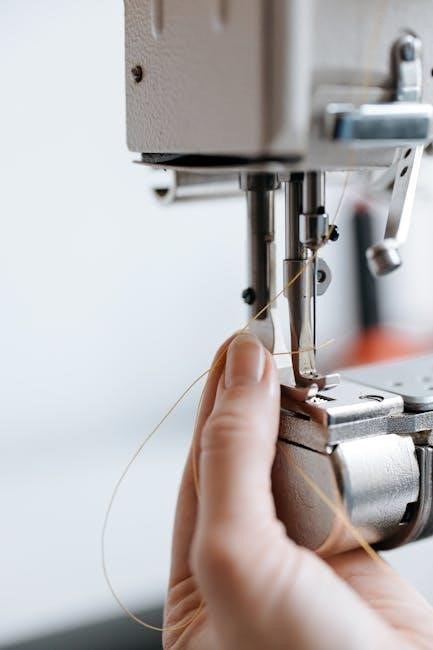
Additional Resources
Explore online forums, repair guides, and vintage sewing communities for Singer manual sewing machine support. Find parts, tutorials, and troubleshooting tips to enhance your sewing experience.
13.1 Recommended Reading and Tutorials
For mastering the Singer manual sewing machine, explore official Singer websites, YouTube tutorials, and sewing blogs. Download free PDF manuals for setup and maintenance. Join online communities like Pinterest and Reddit for tips and inspiration. Vintage sewing groups often share repair guides and troubleshooting advice. Websites like Sewing Parts Online offer detailed tutorials and parts catalogs. These resources provide comprehensive support, helping you optimize your sewing experience and maintain your machine effectively.
13.2 Where to Find Parts and Accessories
To find parts and accessories for your Singer manual sewing machine, visit Sewing Parts Online or Singer’s official website for authentic components. eBay and Etsy offer a wide range of vintage and rare parts, while thrift stores and antique shops may have unique or hard-to-find items. Online forums and sewing communities often connect buyers with sellers of specific parts. For specialized tools or vintage Singer accessories, consider reaching out to sewing machine repair services or collectors. These resources ensure you can maintain and enhance your machine with genuine or compatible parts.

ismaili dua book pdf
You May Also Like

graco tranzitions 3-in-1 manual
May 21, 2025
ismaili dua book pdf
August 11, 2025
